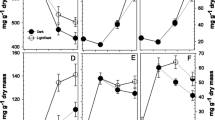Summary
The role of indolylacetic acid (IAA) in influencing the movement of radiophosphorus from a remote locus has been investigated in the decapitated stems of Pisum sativum (var. Meteor) and disbudded shoots of Populus robusta. It has been shown after only a few hours that the radioisotope accumulates at the region where the auxin was applied. By steam-girdling experiments with pea, it was established that auxin-induced transport occurs via the phloem and other obserbations suggest that this effect may be independent of growth. When tri-iodobenzoic acid was applied together with IAA at the stump or to the surface of the stem between the IAA source and the injection point of the tracer, the transport of 32P along the stem was greatly reduced. Of a number of auxin-type substances tested, only naphthoxyacetic acid gave a comparable response to that obtained with IAA, whilst other growth regulators such as kinetin or gibberellic acid did not stimulate 32P transport.
Studies with isolated poplar cuttings showed that auxin-induced transport could only be demonstrated by completely disbudded shoots. Again, phloem transport seemed to be involved and the movement of 32P could be more readily induced in an acropetal direction.
The results are discussed in relation to some recently proposed theories concerning the mechanism of translocation in the phloem.
Zusammenfassung
Der Einfluß der Indolylessigsäure (IES) auf die Wanderung von radioaktivem Phosphor wurde an dekapitierten Sprossen von Populus robusta nach Entfernung ihrer Knospen und an dekapitierten Stengeln von Pisum sativum (var. Meteor) untersucht. Bereits nach wenigen Stunden war eine Anhäufung von 32P am Ort der Auxinzufuhr zu erkennen. Durch Dampf-Ringelungsversuche ließ sich bei Pisum zeigen, daß der Auxin-induzierte Transport über das Phloem erfolgt; weitere Beobachtungen lassen darauf schließen, daß dieser Effekt unabhängig vom Wachstum sein dürfte. Wenn man gleichzeitig mit IES Trijodbenzoesäure (TIBA) auf die apikale Schnittfläche aufbringt oder in einer Zone zwischen Auxinquelle und Injektionsstelle des 32P als Paste auf die Oberfläche des Sprosses aufträgt, so wird der Längstransport des markierten Phosphors erheblich gehemmt.
Es wurden auch noch einige andere Verbindungen von Wuchsstoffcharakter geprüft. Von ihnen führte nur Naphthyloxyessigsäure zu einem ähnlichen Effekt wie IES; andere Wachstumsregulatoren wie Kinetin oder Gibberellinsäure förderten den 32P-Transport nicht.
Untersuchungen an isolierten Pappelsprossen zeigten, daß der auxininduzierte Stofftransport nur in solchen Sprossen zu beobachten ist, deren Knospen vollständig entfernt worden waren. Auch hier scheint es sich um einen Transport im Phloem zu handeln. Die Wanderung von 32P ließ sich stets leichter in akropetaler Richtung induzieren.
Die geschilderten Ergebnisse werden in Beziehung zu einigen neuerdings vorgeschlagenen Theorien des Transportmechanismus im Phloem diskutiert.
Similar content being viewed by others
References
Booth, A., J. Moorby, C. R. Davies, H. Jones, and P. F. Wareing: Effects of indolyl-3-acetic acid on the movement of nutrients within plants. Nature (Lond.) 194, 204–205 (1962).
Canny, M. J.: The mechanism of translocation. Ann. Bot. (N.S.) 26, 603–617 (1962).
Dubuy, H. G., and R. A. Olson: The relation between respiration, protoplasmic streaming and auxin transport in the Avena coleoptile, using a polarographic microrespirometer. Amer. J. Bot. 27, 401–413 (1940).
Fensom, D. S.: The bioelectric potentials of plants and their functional significance. I. An electro-kinetic theory of transport. Canad. J. Bot. 35, 573–582 (1957).
Gunning, B. E. S., and W. K. Barkley: Kinin-induced directed transport and senescence in detached oat leaves. Nature (Lond.) 199, 262–265 (1963).
Hill, G. P.: Exudation from aphid stylets during the period from dormancy to budbreak in Tilia americana (L.). J. exp. Biol. 37, 144–151 (1962).
Libbert, E.: Trijodbenzoesäure und die Stoffleitung bei höheren Pflanzen. Planta (Berl.) 53, 612–627 (1959).
MacIntyre, G. I.: Mechanism of apical dominance in plants. Nature (Lond.) 203, 1190–1191 (1964).
MacReady, C. C.: Movement of growth regulators in plants. I. Polar transport of 2,4-dichlorophenoxyacetic acid in segments from the petioles of Phaseolus vulgaris. New Phytol. 62, 3–18 (1963).
Mitchell, J. W., and W. E. Martin: Effect of indoleacetic acid on growth and chemical composition of etiolated bean plants. Bot. Gaz. 99, 171–183 (1937).
Moorby, J.: An investigation of ageing and apical dominance in woody plants. Ph. D. Thesis (Univ. Manchester) 1959.
Mothes, K.: Über das Altern der Blätter und die Möglichkeit ihrer Wiederverjüngung. Naturwissenschaften 47, 337–351 (1960).
—, and L. Engelbrecht: Kinetin-induced directed transport of substances in excised leaves in the dark. Phytochem. 1, 58–62 (1961).
Münch, E.: Die Stoffbewegungen in der Pflanze. Jena: Gustav Fischer 1930.
Niedergang-Kamien, E., and F. Skoog: Studies on polarity and auxin transport in plants. I. Modification of polarity and auxin transport by TIBA. Physiol. Plant. 9, 60–73 (1956).
Osborne, D. J., and M. Hallaway: The rôle of auxins in the control of leaf senecence: Some effects of local applications of 2,4:D on carbon and nitrogen metabolism. Plant Growth Regulation. IVth Inter. Congr. on Plant Growth Regulation, p. 329–338. Iowa State Univ. Press 1959.
Penot, M.: Déplacements libériens du phosphore liés aux appels de croissance. C. R. Acad. Sci. (Paris) 253, 2105–2109 (1961).
Seth, A. K., and P. F. Wareing: Interaction between auxins, gibberellins and kinins in hormone-directed transport. Life Sci. 3, 1483–1486 (1964).
Spanner, D. C.: The translocation of sugars in sieve tubes. J. exp. Bot. 9, 332–342 (1958).
Stuart, N. W.: Nitrogen and carbohydrate of kidney bean cuttings as affected by treatment with indoleacetic acid. Bot. Gaz. 100, 298–311 (1939).
Thaine, R.: Transcellular strands and particle movement in mature sieve tubes. Nature (Lond.) 192, 772–773 (1961).
—: A translocation hypothesis based on the structure of plant cytoplasm. J. exp. Bot. 13, 152–160 (1962).
Thimann, K. V., and B. M. Sweeney: The effect of auxins upon protoplasmic streaming. J. gen. Physiol. 21, 123–135 (1937).
Turner, T. S., J. MacRae, and P. Grant-Lipp: Auxin and protoplasmic streaming — an oxygen effect. Rep. and Commun. 8th Inter. Bot. Congr., Paris 1954, Sect. II, p. 152–155.
Went, F. W.: Allgemeine Betrachtungen über das Auxinproblem. Biol. Zbl. 56, 449–463 (1936).
Author information
Authors and Affiliations
Rights and permissions
About this article
Cite this article
Davies, C.R., Wareing, P.F. Auxin-directed transport of radiophosphorus in stems. Planta 65, 139–156 (1965). https://doi.org/10.1007/BF00384993
Received:
Issue Date:
DOI: https://doi.org/10.1007/BF00384993




